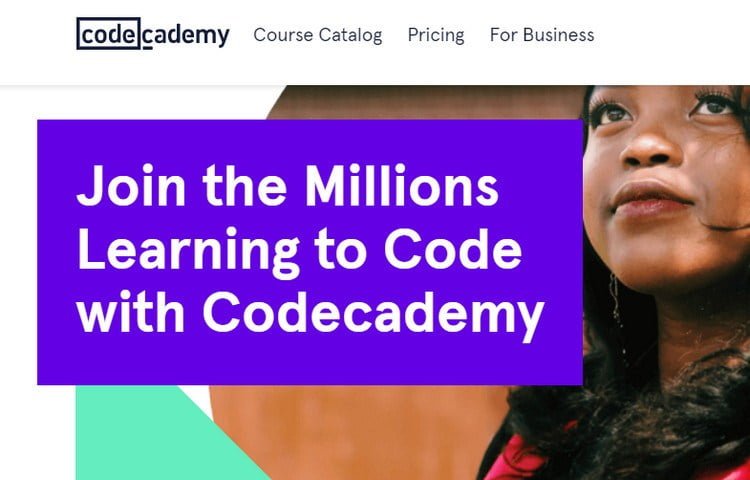This Codecademy review explains how much Codecademy costs and explores their most popular courses and career paths.

What is Codecademy?
Codecademy is an online learning platform that teaches 14 programming languages and 13 subjects, from web development to business. Students progress through the lessons using a three-panel learning interface. The panel on the left has instructions, the center panel contains the code, and the panel on the right contains the output produced by the code.
Codecademy does not provide a way for students to interact with instructors, but there is a community forum where you can get help from other users. Each lesson has its own thread in the forum, and there is a link from the lesson to the forum thread to make it easy to find the answers to your questions if you have trouble with a lesson.
You might be wondering, “Is Codecademy free?” You can choose either a free or paid membership, depending on what you want to learn. Codecademy offers over 60 free courses, covering everything from live streams to language parsing. You can learn C++, linear algebra, computer architecture, and Java ––
However, all of Codecademy’s skill paths and career paths require a Codecademy Pro membership, as do some of its shorter courses. Codecademy Pro members can choose from six career paths consisting of 67-145 lessons each, or they can choose from 33 different skill paths, some of which include a final project. Pro membership also includes extra practice and quizzes.
What career paths does Codecademy offer?
Codecademy offers six main career paths, each of which is tailored to provide students with the skills they need to start a career in that field. Codecademy Pro members can choose from the back-end engineer, computer science, data analyst, data scientist, front-end engineer, and full-stack engineer career paths.
- Back-End Engineer: This 100-lesson career path provides a strong foundation in the skills needed to become a back-end engineer. It takes about four months to complete. Students start with programming client-side interfaces and servers and move on to designing databases. This career path includes design patterns, Express.JS, Node.JS, PostgreSQL, SQL, and TDD.
- Computer Science: This 67-lesson career path takes about 20 weeks to complete and teaches students to think like programmers. It covers the fundamentals of computer science, teaches problem-solving, and helps students build a portfolio they can use when applying for jobs. Students learn command line, data structures, Git, and Python.
- Data Analyst: The data analyst career path consists of 67 lessons that cover Matplotlib, NumPy, Pandas, Python 3, SciPy, and SQL. Students learn how to analyze and understand large sets of data. They create a professional portfolio while expanding their analytical skills. This career path takes about 28 weeks to complete.
- Data Scientist: This 85-lesson course takes about 35 weeks to complete. It teaches students to analyze data and communicate their findings about that data to other people in their organization. Students also learn to use machine learning to make predictions. This career path covers Matplotlib, NumPy, Pandas, Python 3, Scikit-learn, and SQL.
- Front-End Engineer: The front-end engineer career path consists of 121 lessons that make up 350 hours of learning. Students learn how to build interactive web apps and websites that are fast, functional, and beautiful. This course teaches the fundamentals of design and teaches students how to think like front-end engineers. It covers accessibility, CSS, HTML, JavaScript, React, Redux, and web apps.
- Full-Stack Software Engineer: The longest of the career paths, this path takes about six months to complete and comprises 145 lessons. Students start with front-end design and then learn back-end design before learning how to connect the two. They learn how to build interactive websites and communicate with other web developers. This career path covers Express.JS, JavaScript, Node.JS, React, SQL, and TDD.
What are the most popular courses on Codecademy?
The most popular courses on Codecademy are introductory programming courses for beginners: Learn HTML, Learn Java, Learn JavaScript, and Learn Python 3. Learn Python 3 requires a Codecademy Pro membership, but the other three courses can be taken for free. However, if you have a pro membership, you can get a certificate of completion for any of these courses.
Learn HTML: Learn HTML teaches HTML, which forms the foundation of all web pages. The course takes nine hours to complete and has no prerequisites. It is broken into four lessons: elements and structure, tables, forms, and semantic HTML.
Learn Java: Learn Java teaches students how to program with Java, which is one of the most popular programming languages. It is used in large systems development, mobile applications, and software development. The mobile operating system Android is written in Java. This course includes 11 lessons and seven Java projects. It takes 25 hours to complete.
Learn JavaScript: Learn JavaScript teaches JavaScript, which is a web programming language. It takes 30 hours to complete. Students learn object-oriented programming concepts and programming fundamentals in 14 lessons that build on one another. After completing this course, the student will be ready to move on to a course on building web applications with React, building interactive websites, or building games.
Learn Python 3: Learn Python 3 is a pro-level course that requires a Codecademy Pro membership. This course consists of 14 lessons and takes 25 hours to complete. Students learn how to program in Python 3, which can be used for software development, web development, and data science applications.
Who is Codecademy for?
Codecademy is geared toward the beginning coder, with all of its courses at the beginner or intermediate level. Students should be self-motivated and comfortable with self-paced learning. It’s up to you to commit to logging on every day and completing a few lessons. Without motivation, you’re not likely to finish the courses you’ve enrolled in.
What is Codecademy Cost ?
- You can get this for lifetime from Keys-shop.in, buy from this link – https://keys-shop.in/product/codecademy-learn-to-code-2/

